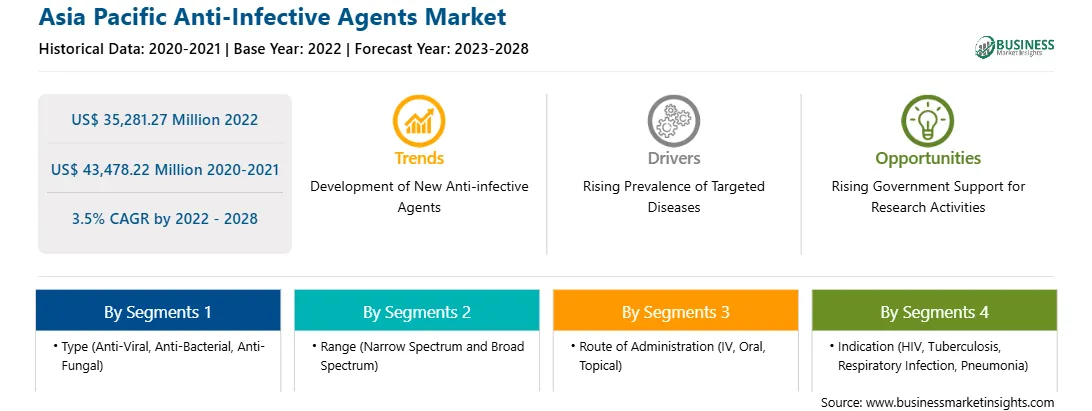The APAC anti-infective agents market was valued at US$ 35,281.27 million in 2022 and is projected to reach US$ 43,478.22 million by 2028. It is expected to grow at a CAGR of 3.5% during the forecast period.
Continued development of new anti-infective agents is a major driving force behind the growth of the Asia Pacific anti-infective agents market. Developments in the medical devices industry have motivated existing players and new entrants to introduce their novel products in the market. Additionally, there have been lots of developments in techniques involved in medical examinations. The use of illuminating light sources with longer shelf life in gynecological procedures is encouraging market players to develop and introduce anti-infective agents.
TLRs, or toll-like receptors, are important components of innate immunity. They have the ability to detect a variety of microbes, including viruses, bacteria, fungi, and protozoa. Innate immunological reactions can directly influence adaptive immune reactions. Therefore, TLRs are considered therapeutic targets for autoimmune diseases, including autoimmune disorders, allergies, sepsis, and cancer. 2 COVID-19 vaccines were created using mRNA technology (Pfizer-BioNTech35 and Moderna36), demonstrating safety and high efficacy. Such developments are expected to present lucrative opportunities to the Asia Pacific anti-infective agent market in the years to come.
Vendors can attract new customers and expand their footprints in emerging markets with new features and technologies. This factor is likely to drive the Asia Pacific anti-infective agents market at a good CAGR during the forecast period.
Strategic insights for the Asia Pacific Anti-Infective Agents provides data-driven analysis of the industry landscape, including current trends, key players, and regional nuances. These insights offer actionable recommendations, enabling readers to differentiate themselves from competitors by identifying untapped segments or developing unique value propositions. Leveraging data analytics, these insights help industry players anticipate the market shifts, whether investors, manufacturers, or other stakeholders. A future-oriented perspective is essential, helping stakeholders anticipate market shifts and position themselves for long-term success in this dynamic region. Ultimately, effective strategic insights empower readers to make informed decisions that drive profitability and achieve their business objectives within the market. The geographic scope of the Asia Pacific Anti-Infective Agents refers to the specific areas in which a business operates and competes. Understanding local distinctions, such as diverse consumer preferences (e.g., demand for specific plug types or battery backup durations), varying economic conditions, and regulatory environments, is crucial for tailoring strategies to specific markets. Businesses can expand their reach by identifying underserved areas or adapting their offerings to meet local demands. A clear market focus allows for more effective resource allocation, targeted marketing campaigns, and better positioning against local competitors, ultimately driving growth in those targeted areas.Asia Pacific Anti-Infective Agents Strategic Insights

Asia Pacific Anti-Infective Agents Report Scope
Report Attribute
Details
Market size in 2022
US$ 35,281.27 Million
Market Size by 2028
US$ 43,478.22 Million
Global CAGR (2022 - 2028)
3.5%
Historical Data
2020-2021
Forecast period
2023-2028
Segments Covered
By Type
By Range
By Route of Administration
By Indication
By Distribution Channel
Regions and Countries Covered
Asia-Pacific
Market leaders and key company profiles
Asia Pacific Anti-Infective Agents Regional Insights

Asia Pacific Anti-Infective Agents Market Segmentation
The Asia Pacific anti-infective agents market is segmented based on type, range, route of administration, indication, distribution channel, and country. Based on type, the market is segmented into anti-bacterial, anti-viral, anti-fungal, and others. The anti-viral segment is expected to account for the largest market share by the end of 2022.
Based on range, the market is segmented into broad spectrum and narrow spectrum. By the end of 2022, the narrow spectrum segment will likely hold a larger market share.
Based on route of administration, the market is segmented into topical, oral, IV, and others. By the end of 2022, the IV segment is likely to hold the largest market share.
Based on indication, the market is segmented into HIV, tuberculosis, respiratory infection, pneumonia, and others. In 2022, the others segment is projected to hold the largest share of the market.
Based on distribution channel, the market is segmented into hospital pharmacies, specialty pharmacies, e-commerce, and others. By the end of 2022, the hospital pharmacies segment is likely to hold the largest market share.
Based on country, the market is segmented into Australia, China, India, Japan, South Korea, and the Rest of Asia Pacific. China is expected to hold the largest market share by the end of 2022.
Abbott; Allergan Plc.; Astellas Pharma Inc.; Bayer AG; Boehringer Ingelheim International GmbH; Bristol-Myers Squibb Company; F. Hoffmann-La Roche Ltd.; Gilead Sciences, Inc.; GlaxoSmithKline plc.; Merck & Co., Inc.; and Novartis AG are the leading companies in the Asia Pacific anti-infective agents market.
The Asia Pacific Anti-Infective Agents Market is valued at US$ 35,281.27 Million in 2022, it is projected to reach US$ 43,478.22 Million by 2028.
As per our report Asia Pacific Anti-Infective Agents Market, the market size is valued at US$ 35,281.27 Million in 2022, projecting it to reach US$ 43,478.22 Million by 2028. This translates to a CAGR of approximately 3.5% during the forecast period.
The Asia Pacific Anti-Infective Agents Market report typically cover these key segments-
The historic period, base year, and forecast period can vary slightly depending on the specific market research report. However, for the Asia Pacific Anti-Infective Agents Market report:
The Asia Pacific Anti-Infective Agents Market is populated by several key players, each contributing to its growth and innovation. Some of the major players include:
The Asia Pacific Anti-Infective Agents Market report is valuable for diverse stakeholders, including:
Essentially, anyone involved in or considering involvement in the Asia Pacific Anti-Infective Agents Market value chain can benefit from the information contained in a comprehensive market report.